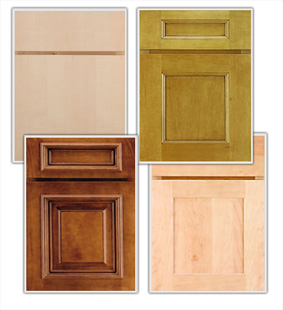The right type of finish can add warmth and depth to your cabinets and bring your kitchen or bathroom to life. There are a variety of cabinet finishing techniques to choose from, each providing a different appearance. The proper finish will give your wooden cabinets a beautiful look and help to protect them for years to come. Here are a few of the most popular cabinet finishing techniques.
Glaze– A glaze is a semi-transparent color that is applied over a stain. The glaze is applied to the wood and then wiped off by hand. It then settles into the grain and gives a nice, even wash of color and detail. This cabinet finishing technique adds depth, dimension and a slight sheen to your cabinets. When applied to the corners, glaze accentuates the carved details of the door for an artistic look. You can also control the amount of glaze applied depending on what look you are going for. An even and consistent coverage produces a more subtle appearance, while a heavier and more varied appearance gives a dramatic look. Since glazes come in a variety of tinted colors, it’s important to take the natural wood color into consideration when choosing a glaze to apply on top of it.
Stain– A stain is an easy way to enhance the natural beauty and grain of the wood. It gives a transparent color for a more natural look. Before applying a stain, the cabinet’s surface must be sanded so that the stain can absorb evenly. After applying a stain, you’ll notice that the wood’s natural characteristics-such as streaks, knots and the grain- become more prominent and create lighter and darker spots of color on the cabinets. The color of the stain also can vary across different parts of the door due to the grain.
Distressing– This technique gives a rustic finish with natural imperfections, such as dents, wear marks and scratches. This gives a sense of age and can resemble an antique piece. Distressing is more visible with glazed finishes, so take that into consideration when choosing the finish.
Heirlooming– This finishing technique recreates the natural process of wear for an authentic, aged finish. First, selective sanding will expose the underlying wood to give an impression of the natural wear process. Then the corners and edges are softened and the surface is distressed. Finally, the glaze is applied. This process is very hand-detailed, which helps give the cabinets a beautiful, artistic look.
Burnishing– Burnishing creates the warm, traditional look of furniture that many homeowners are looking for. To begin this technique, the wood is randomly distressed and over sanded. Then a stain is applied for a burnished effect. Lastly, a glaze is added to high-wear areas to provide a softened appearance.

